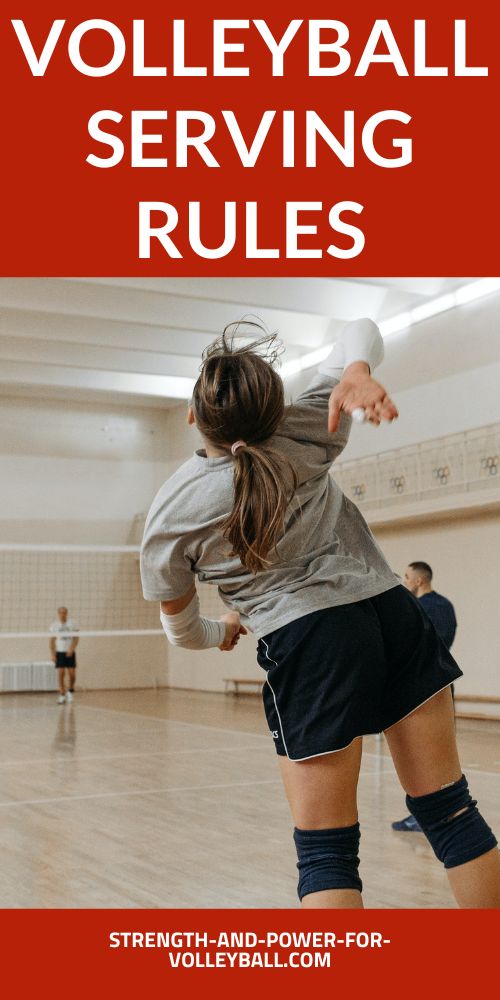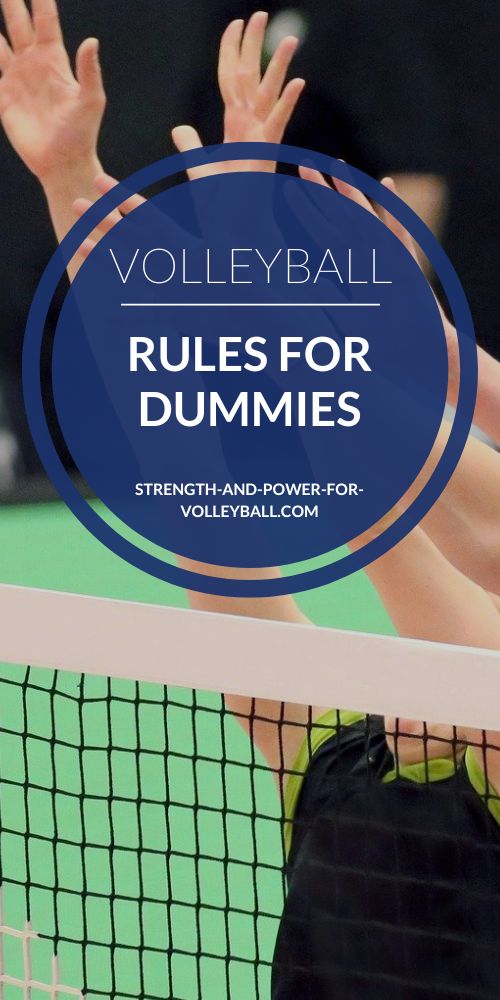Volleyball Rules for Dummies
Court, Rules for Players, & Positions
Volleyball rules for dummies will help all volleyball players, coaches, and fans understand the sport of volleyball.
Volleyball Court, Area, and Lines
Let's first go over the volleyball court.
The sport of volleyball consists of two teams that have 6 players competing on a court that's divided in half. The line that divides the court is called the centerline.
The boundary lines are the lines around the outside of the court that form a rectangle. The court is 60 feet long and 30 feet wide.
Each team stays on their side of the court the entire time.
There's a net that divides the court in half. In women's volleyball the net is positioned 7 feet 4 inches high across the centerline. In men's volleyball, the net is about 8 feet high. There are different heights for different age divisions and levels of play.
The playable area is the area where it's legal for a player to make a play on the ball.
The line that marks the side of the court is called the sideline.
The line that marks the end of the court is called the endline or baseline.
The playable area around the outside of the court is called the free zone.
The area inside the court between the centerline and 10 foot line is called the front court.
The area inside the court between the 10 foot line and endline is called the back court.
There are 10 foot lines (the 3 meter lines) that are 10 feet from the centerline. The 10 foot line is used for different situations.
Here are a few situations where the 10 foot line comes into play.
1) Back row attacks. The first thing to know is that for a ball to be illegally attacked, the entire ball must be above the height of the net. The next thing that must happen is the player must be a back row player. The last thing that must be true for the it to be illegal is the back row player must be in on the 10 foot line or in the front court. If the back row player jumps from the back court (without contacting the 10 foot line), the back row player can legally attack the ball).
2) Libero Finger Action Setting. The libero is a specialized position player that plays in the back court. The purpose of the libero is to help the team with passing and defense. There are situations where it's illegal for the libero to use finger setting action on the ball. When the libero is using finger setting action to direct the ball to an attacker, it's illegal to do this if the libero is in the front court and the player the libero sets ends up attacking the ball (when the ball is completely above the height of the net).
The area outside the court from the 10 foot line to the centerline is called the substitution zone.
Volleyball Sets and Matches - Volleyball Rules for Dummies
Volleyball is made up of games called sets.
In indoor volleyball, sets are usually played to 25 points.
In beach volleyball, sets are often played to 21 points.
Match play is usually best of 3 sets or best of 5 sets.
In a tournament, teams will often play match play (best of 3 sets).
Tournaments often have pool play.
Pool play is when teams have a round robin play. This means all the teams in a pool will play each other.
There are different formats for pool play.
The tournament director will determine the format of play.
The most common format is best of 3. Another common format for pool play is to play each team 2 sets.
At the end of pool play, the teams are seeded to play in a single elimination bracket.
Depending on the amount of teams in a tournament, there may be multiple pools.
The tournament director or the organization that's hosting the tournament will determine things like how many pools and what teams are in what pools.
Volleyball Referees and Scorekeeper - Volleyball Rules for Dummies
The referees, scorekeeper, libero tracker, line judges, are the work crew.
There is one referee in charge of the match. This first referee is called the R1.
The 2nd referee is called the R2.
There's a scorekeeper that keeps score using a scoresheet. There's also a person running a visual scoreboard or clock.
There's a person that tracks the libero called the libero tracker. This is a person that keeps track of the libero entering and exiting the match.
Team Bench Area - Volleyball Rules for Dummies
Most teams have a head coach. Some teams will have assistant coaches.
There are players on the team bench called substitutes. Players can substitute into the match during a dead ball. Players are limited to substituting into the match into just one spot in the rotation. When a player plays in a spot, they are restricted to play in this spot in the rotation for the remainder of the set. For rare situations, there are exceptional substitutions where players will enter another spot in the rotation.
A team may have a libero on the bench that will enter the match for back row players.
Depending on the organization and level of play, teams are limited to a certain number of substitutions.
For high school volleyball, a team has a maximum of 18 subs a set.
For USAV, it's 12 subs per set.
Serving Rules - Volleyball Rules for Dummies
There are 6 zones on the court.
Zone 1 is right back. Zone 2 is right front. Zone 3 is middle front. Zone 4 is left front. Zone 5 is left back. Zone 6 is middle back.
Play starts by the first referee R1 whistling and beckoning for serve.
The player in the right back position serves. If the wrong player serves the ball, the referee will blow the whistle and award the opponent a point and the ball.
The receiving team will then rotate positions clockwise. The player that was in zone 2 is know the new server in zone 1.
When a team wins a rally while being the receiving team, that team will rotate positions before serving.
When a team wins a rally while being the serving team, the team won't rotate and will continue to have the same server continue serving.
After whistle for serve, the server has a certain amount of time to serve. For middle school, high school, and 14 and under club volleyball, the server has 5 seconds to serve. For most other situations, the server has 8 seconds to serve.
The server must complete the serve within the serving zone. When jump serving, the server can't take off from outside the extension of the sideline. This means the feet must be entirely within the serving zone when jumping to serve.
The server must toss or release the ball when serving. It's illegal for the server to serve the ball out of the hand.
Rotations and Overlaps - Volleyball Rules for Dummies
Each player on the court must be in their correct spot at the moment of contact for serve. After the ball is served, players can move wherever they want on the court.
There are situation where certain players can't overlap with one another.
Go to this page to learn more about overlaps.
Rules for Front Row Players
There are 3 players on the front row. Front row players can legally block and attack at the net.
There are situations where it's illegal to block.
Rules for Back Row Players
As I mentioned earlier, there are situations where it's illegal for a back row player to attack the ball. There are also situations where a back row player can't block.
For back row attacks, what's important is where the ball is in relation to the height of the net. You need to be focused on is the entire ball above the top of the net when the player makes contact with the ball?
For blocking, what's important is the body being above the net. So, you want to focus on, is the part of the blockers body above the top of the net at the moment of contact?
Learn more about the attacking and blocking rules.
Players Knowing the Rules
Not just coaches, but it's also important for players to know the rules. And certain players need to know certain rules for certain situations.
For example, a setter needs to know the rules for rotations and overlaps really well. It's to the setters advantage to understand the overlapping rules. The setter needs to know where they can position themselves on the court to get an advantage.
Also, if the setter doesn't know the overlapping rules, then the setter may actually be lining up on the court in a way that's creating a disadvantage for their team.
The libero needs to know the rules so they can make good decisions for when to use overhead finger action on the ball to direct the ball to a team to attack.
Front row players need to know attacking and blocking rules so they know when it's legal and when it's illegal to reach over the net to block.
For example, there are situations where the the front row player can force the opposing setter to commit an illegal back row block.
If you enjoyed these tips and would like to keep it close to you at any time, just save this pin to your Pinterest Volleyball Training Board.
- Home
- Basic Rules
- Volleyball Rules for Dummies

